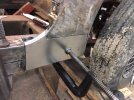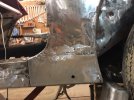JMO but with something you have no access to the backside, and you are using a MIG you have to accept that you will get some shrinkage. The trick is to minimize it. I differ slightly from what's been posted here in that I would just use tacks, running those stitch welds will cause it to shrink more than just tacking it alone, and I never would blow on it to cool it. The act of blowing on very hot/nearly molten metal will actually cause it to shrink.
I would start by tacking it in, skipping around till it was holding on it's own. I would give it some time to cool after a few tacks. When you have it tacked in, slightly grind the tacks and use a wire brush on a drill to keep the panel clean and free from any cruddy buildup that you get when MIG welding. Then make a series of tacks, skipping around, approximately 1/2 distance from the first set of tacks. Again let it cool on it's own after every 3 or 4 tacks. Grind, brush it and repeat. Once the tacks start getting sort of close to one another then start making your tacks overlap your previous ground ones. This will help with not having pinholes. Again after each series of tacks grind some of the proud off. Take your time and let it cool frequently. Once you have "connected the dots" then grind flush and inspect for pinholes. There will be some so in those places tack again. Repeat this until you see no pinholes.
As for settings practice on scrap first. You want it hot but not so hot it just burns through. Experiment till you find the settings that work on your welder.
Doing it this way, provided you don't get in a hurry, you will have very minimal shrinkage. Easily will be covered by a skim coat of filler. Don't forget to treat the backside with some cavity wax or by sloshing some epoxy in there.


